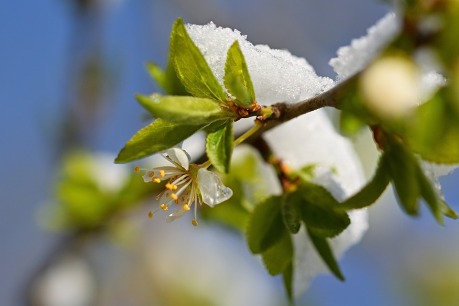
Frozen Cherry Bloom Image by jggrz from Pixabay
The summer- like temperatures have been nice to have around, but we knew they couldn’t last. The warm weather subsided and snapped us back into the reality that we are only a week into April. The recent temperature fluctuations not only had us wearing shorts and sweat pants in the same week, but they also could have some impacts in our landscapes.
Even though the warm 70+ degree days have been nice for us to break out of the winter blues, our plants could still have a tough spring. While the blooms and buds are nice to look at, the reality is that our average frost free date is around Mother’s Day. This means at any point between now and then there is the potential for frost and who could forget that in Nebraska there is always the possibility of a late snow.
The downside of a warm spring is the potential for plant damage in the event of a cold snap or snow. Roses and some perennials can have some damage and dieback to the new growth and into the canes if they were pruned prior to the cold temps. Flowering bulbs can have damage to the foliage and flowers present at the time of the freeze. Trees and shrubs with their blooms exposed during the time of a frost or a snow can have damage to the bloom and to the emerged leaves. The good news is that most trees and shrubs can put on a second set of leaves if the first ones to emerge are damaged due to cold temperatures. Flowers on the other hand are different story, the tree will not put on a second set of flower buds if the first ones are damaged. Growing a second set of leaves takes a tremendous amount of energy for the tree. Using all of that energy toward making new leaves can leave some trees stressed. To help the stressed trees, make sure they have at least an inch of supplemental water a week. Also avoid fertilizing the tree or shrub and be on the lookout for insects or diseases that often hit weakened trees.
The extent of the cold damage depends on many things. The location of the plant material in the landscape can play a big role in how the plants are affected. Plants located on the south or west side of a brick house can be further along in their growth stage than those on the east side of a home with wood siding due to the reflected heat. Plants located in a low spot or at the bottom of a hill also have greater potential for cold damage than those at the top of a hill due to the pooling effect of cold air. The type of plant material and the growth stage that it is in can also play a role on the extent of the damage when we get a cold snap. Observing your unique landscape is the best way to survey the damage left behind by the cold temperatures.
With the nice temperature, everyone has chomping at the bit to get their preemergence herbicides down. Don’t let air temperatures fool you, it’s the soil temperatures that matter. Just because we might have several nice days in a row, doesn’t mean the soil temperatures are increasing rapidly. Always check the average soil temperatures at the 4” depth to be sure. If crabgrass does happen to germinate before April 15th, there is a chance that the little seedlings could get hit by frost yet this spring.
Preemergence herbicides are designed to prevent seeds from sprouting. The three most common active ingredients in preemergence herbicides are dithiopyr, pendimethalin, or prodiamine. When choosing a product to control crabgrass, look for one of those active ingredients. Once a plant is up and actively growing, not all preemergence herbicides will work on crabgrass seedlings so be sure to read the label. For best results, water in the preemergence products after application to keep them from degrading in the sun. Split applications of preemergence herbicides will allow for extended control. Aim to put down half the highest recommended application rate on the label when the soils are close to 50 degrees and the other half in 6-8 weeks later. This allows for a longer season of control for weeds. One application now probably won’t last throughout the entire growing season due to the earlier application window.
Take advantage of the warm weather when we can, get out, soak up some sun, check your landscape plants, and prepare to do battle against crabgrass when the soil temperatures are right.
Elizabeth Killinger is the Horticulture Extension Educator with Nebraska Extension in Hall County. For more information contact Elizabeth at elizabeth.killinger@unl.edu, her blog at https://huskerhort.com/, or HuskerHort on Facebook and Twitter.
